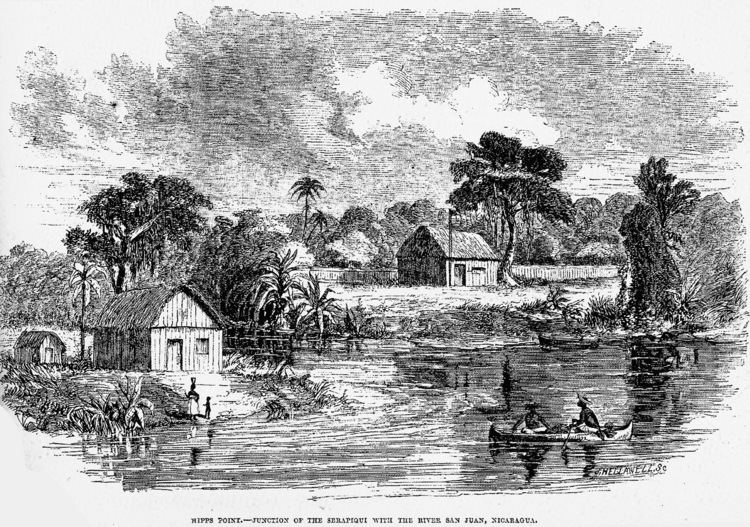Period 1856 – 1857 | ||
 | ||
2,518 mercenaries Unknown total* 2,500 troops* 4,000 troops 1,000 combatants dead (all causes) 4,000-6,000 combatants dead (all causes)~5,000 wounded Similar Second Battle of Rivas, Battle of Santa Rosa, Costa Rican Civil War, Battle of San Jacinto, United States occupatio | ||
The Filibuster War was a military conflict between filibustering multinational troops stationed in Nicaragua and a coalition of Central American armies.
Contents
Initial stages
In 1854, a civil war erupted in Nicaragua between the Legitimist party (also called the Conservative party), and the Democratic party (also called the Liberal party). The Democratic party sought military support from William Walker who, to circumvent American neutrality laws, obtained a contract from Democratic president President Castellón to bring as many as three hundred "colonists" to Nicaragua. Walker sailed from San Francisco on May 3, 1855, with approximately 60 men. Upon landing, the force was reinforced by 170 locals and about 100 Americans.
Establishment of Walker
With Castellón's consent, Walker attacked the Legitimists in the town of Rivas, near the trans-isthmian route. He was driven off, but not without inflicting heavy casualties. On September 4, during the Battle of La Virgen, Walker defeated the Legitimist army. On October 13, he conquered the Legitimist capital of Granada and took effective control of the country. Initially, as commander of the army, Walker ruled Nicaragua through puppet President Patricio Rivas. U.S. President Franklin Pierce recognized Walker's regime as the legitimate government of Nicaragua on May 20, 1856.
Central American counterattack
Walker had scared his neighbors with talk of further military conquests in Central America. Juan Rafael Mora, President of Costa Rica, rejected Walker's diplomatic overtures and instead declared war on his regime. Walker sent Colonel Schlessinger to invade Costa Rica in a preemptive action, but his forces were defeated at the Battle of Santa Rosa in March 1856. In April 1856, Costa Rican troops penetrated into Nicaraguan territory and inflicted a defeat on Walker's men at the Second Battle of Rivas, in which Juan Santamaría, later to be recognized as one of Costa Rica's national heroes by burning the place were the Filibuster were staying. Walker set himself up as President of Nicaragua, after conducting an uncontested election. He was inaugurated on July 12, 1856, and soon launched an Americanization program, reinstating slavery, declaring English an official language and reorganizing currency and fiscal policy to encourage immigration from the United States of America.
Meanwhile, government representatives from Honduras, El Salvador and Guatemala signed in the City of Guatemala a Treaty of Alliance on July 18, 1856, for "defense of its sovereignty and independence" also recognized Patricio Rivas as president of Nicaragua. Costa Rica could not attend at that time to the alliance because of the havoc that cholera disease had caused in their troops, but would resume actions later. Also, democratic and loyalist factions allied to Patricio Rivas, signed on 12 September, a "Providential Pact" declaring war against William Walker. For September 14, Septentrión Army (as the allied army was called) forces managed the first victory of the patriots Nicaraguans in the so-called Battle of San Jacinto.
By the end of 1856, Walker ordered the destruction of Granada.
The Costa Rican government resumed action in late 1856, and developed plans to take over the San Juan River in order to cut Walker's supply of weapons and new recruits. Cornelius Vanderbilt sent one of his agents, Sylvanus Spencer, to collaborate with the Costa Rican army in order to recover the possession of the Transit Company he had lost to Walker. Spencer arrives to San Jose in November 1856 and it is assigned to a company under Major Maximo Blanco to take over the steamers of the Transit Company. By January 1857, the Costa Rican army was in control of the San Juan River and all the steamers of the Transit Company.
Meanwhile, Walker was expelled from Granada by the rest of the allied armies. Some reinforcements under the command of Lockridge and Titus tried to recover the control of the River from the Costa Ricans, unsuccessfully. By April 1857, Walker had taken Rivas again, and the allies had laid siege to the city, in what became known as the Third Battle of Rivas.
Walker's surrender
On May 1, 1857, Walker surrendered to Commander Charles Henry Davis of the United States Navy and was repatriated. Upon disembarking in New York City, he was greeted as a hero, but he alienated public opinion when he blamed his defeat on the U.S. Navy.
Brief chronology
, 1855
, 1856
, 1857
